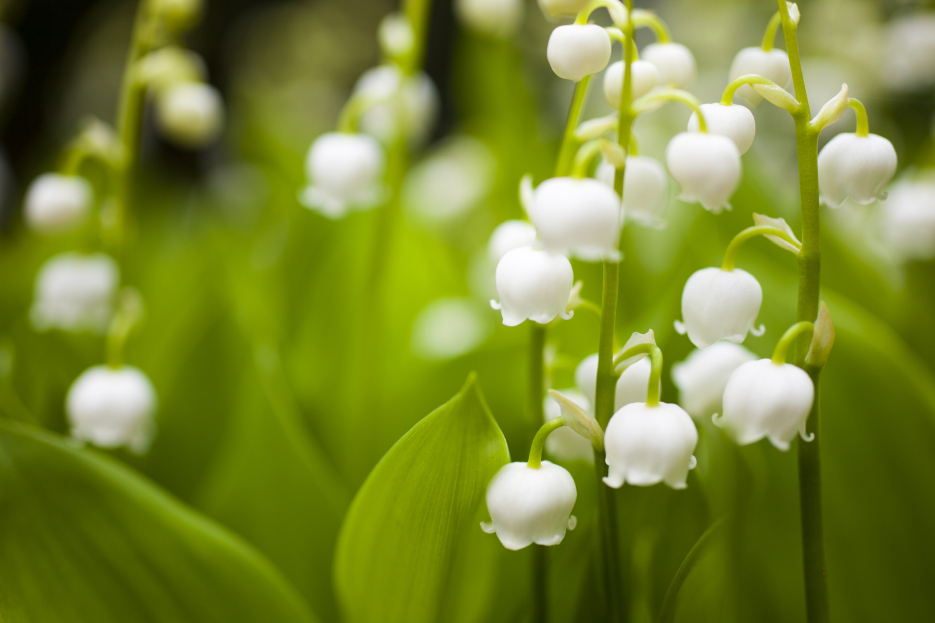
Lily of the Valley (Convallaria majalis) is a fragrant and delicate perennial plant known for its sweet-smelling, bell-shaped white flowers that bloom in spring. While traditionally grown outdoors, Lily of the Valley can also be cultivated as a houseplant. With its lush green foliage and enchanting blossoms, it’s a lovely addition to any indoor garden. If you're thinking of growing Lily of the Valley indoors, here's a complete guide on how to care for this charming houseplant.
Lily of the Valley thrives in bright, indirect light. While it can tolerate low light conditions, it will not flower as prolifically without sufficient light. A spot near a north or east-facing window is ideal, as it will receive soft, filtered light throughout the day. Avoid placing your Lily of the Valley in direct sunlight, as this can scorch the delicate leaves and flowers.
If you don't have a naturally bright spot, you can use grow lights to provide the necessary light for your plant. However, be mindful not to expose it to too much direct light, which can cause the plant to become leggy and stressed.
Lily of the Valley prefers consistently moist soil, but it does not like to be waterlogged. To figure out the right balance, water your plant when the top 1-2 inches of soil feel dry to the touch. Be sure to water thoroughly, allowing excess water to drain out of the bottom of the pot. It's essential to ensure that the pot has good drainage to prevent water from accumulating at the bottom, which can lead to root rot.
During the growing season (spring and summer), you may need to water more frequently, as the plant is actively growing and flowering. In the winter months, the plant’s growth slows down, so you can reduce watering slightly. Always check the soil moisture before watering to avoid overwatering, which can harm the plant.
Lily of the Valley prefers well-draining, slightly acidic soil. A standard potting mix for houseplants is typically sufficient, but you can mix in some perlite or sand to improve drainage. The soil should be rich in organic matter to provide the nutrients your plant needs to thrive.
When choosing a pot, make sure it has drainage holes to prevent water from accumulating at the bottom. Root rot can be a common issue if the plant is sitting in stagnant water. If your Lily of the Valley is growing in a container, consider repotting it every couple of years to refresh the soil and provide more space for the roots to grow.
Lily of the Valley grows best in cool to moderate temperatures, typically between 50°F and 70°F (10°C to 21°C). It can tolerate slightly cooler temperatures, making it a great plant for cooler indoor spaces. However, it’s important to keep it away from drafts, as sudden temperature fluctuations can stress the plant.
Lily of the Valley also enjoys moderate humidity levels. If your indoor air is dry, especially during the winter, you can increase humidity by placing a humidity tray filled with water and pebbles under the plant or using a room humidifier. Alternatively, you can mist the leaves with water occasionally, but be sure not to overdo it, as excess moisture on the leaves can lead to fungal issues.
Lily of the Valley is not a heavy feeder, but it can benefit from occasional fertilization during the growing season. Use a balanced, water-soluble fertilizer, such as a 10-10-10 formula, diluted to half strength. Fertilize your plant every 4-6 weeks from early spring to late summer, when the plant is actively growing and flowering.
During the fall and winter months, when the plant is dormant, you can stop fertilizing, as the plant’s growth slows down. Over-fertilizing during the dormant period can cause the plant to become stressed or weak.
Deadheading (removing spent flowers) is an important part of caring for Lily of the Valley. Once the flowers have faded, trim the flower stalks back to the base of the plant to encourage new growth and prevent the plant from expending energy on seed production. This will also help keep the plant looking tidy.
In addition to deadheading, you can prune away any yellow or damaged leaves to maintain the plant’s appearance and health. However, avoid cutting back the foliage too drastically, as the leaves are essential for photosynthesis and the plant’s overall well-being.
Lily of the Valley is relatively resistant to pests and diseases, but it can occasionally attract aphids, spider mites, or mealybugs. If you notice small pests on the leaves or a sticky residue, check the plant carefully. You can treat pests by spraying the plant with insecticidal soap or neem oil, or by wiping the leaves gently with a damp cloth.
The plant can also be susceptible to fungal diseases like powdery mildew, especially in humid conditions. To prevent fungal issues, make sure your plant has good air circulation, avoid overhead watering, and remove any infected leaves promptly.
During the winter months, Lily of the Valley may enter a period of dormancy. To help the plant through this time, reduce watering and keep it in a cool, well-lit location. You can also cut back any dead or damaged growth.
If you live in a region with cold winters, you can bring your Lily of the Valley indoors to continue growing as a houseplant. While the plant may not bloom as much during the winter, it will rebound in the spring when it receives more light and warmth.
Lily of the Valley is not pet safe. It is toxic to both cats and dogs if ingested. The plant contains compounds called cardiac glycosides, which can cause symptoms such as vomiting, diarrhea, drooling, and in severe cases, heart arrhythmias. If you have pets in your home, it’s important to keep Lily of the Valley out of reach or choose a safer alternative.